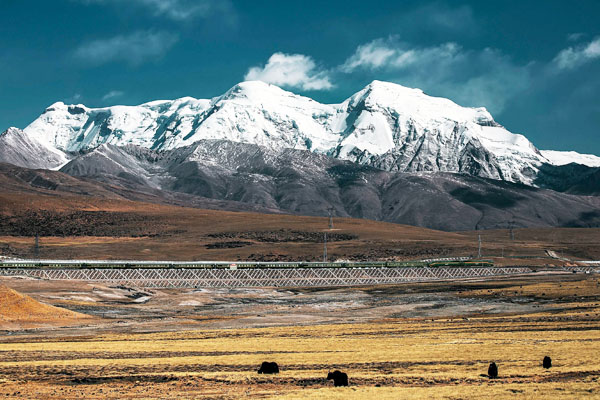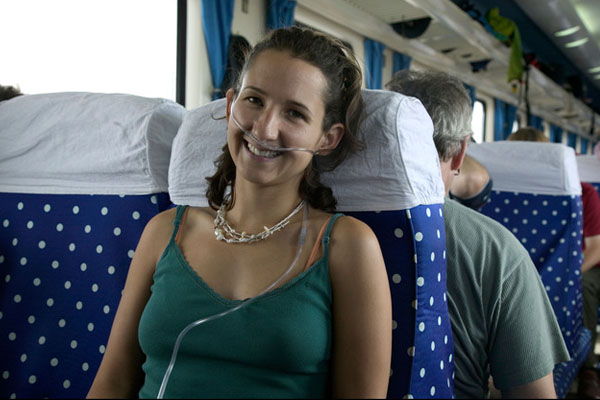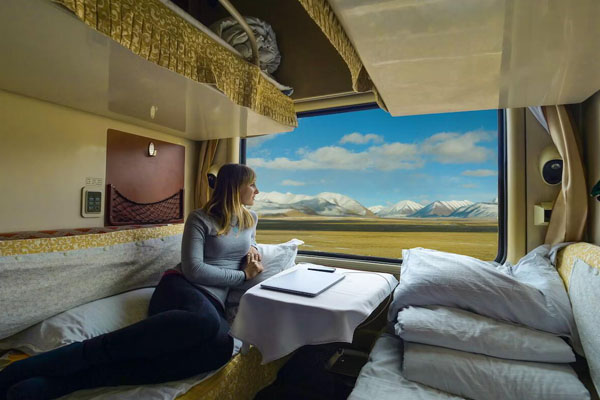Ride the Train, Don't Fly: the Perfect Way to Get to Lhasa
When traveling to Tibet, there are three main ways you can do it: by plane, by train, and by road. While planes are faster, there are more advantages to taking a train. Check this article to know why it is recommended to get to Lhasa by train.
1. Witness the World-Record Qinghai-Tibet Railway
The Qinghai-Tibet Railway is a world miracle. Much of the tracks of the railway are at an altitude above 4,000 meters, as the train races across the plains and prairies to its destination. It passes by some of the world’s most amazing sights, such as the Kunlun Mountain Range, Kekexili Nature Reserve, Lake Namtso, and the Tanggula Mountain Pass, which is the highest railway pass in the world, at 5,072 meters.
 Qing-Tibet train passes Tanggula Mountain.
Qing-Tibet train passes Tanggula Mountain.The Qingzang Railway also holds several other world records. This 1,956-kilometer-long railway is the first of its kind in the world and connects Tibet with China. 960km of the track is at an elevation of over 4,000 meters, and it is recorded as the world’s highest railroad. It also incorporates the Fenghuoshan Tunnel, the world’s highest tunnel, and the Kunlun Mountain Tunnel, which is the longest tunnel built on permafrost. Finally, the Qingshuihe Bridge, which is the longest railway bridge on the line at 11.7 km in length.
2. Take in the Amazing Scenery along the Train Journey to Lhasa
Aside from these amazing facts, the scenery along the route of the train is spectacular. From prairies and plains dotted with gazelles and yaks to the high mountains that tower above the tracks along most of the route. In addition, the lakes are breathtakingly beautiful, glinting in the sun as birds skim across the waters and nomadic herdsmen graze their animals on the shores. The entire length of the Qingzang Railway is a wonder filled with amazing sights and spectacular views. It is worth the 22-hour trip from Xining just to see these breathtaking sights.
 Beautiful scenery along the Qinghai-Tibet Railway
Beautiful scenery along the Qinghai-Tibet RailwayAs if that were not enough, life on the train is an experience worth taking as well. While the trains from the rest of China are relatively small, the train from Xining is the largest of all, with more carriages and seats available to passengers. This means that there is a better chance of getting a train ticket from Xining than from any other location in China, especially in the peak season.
3. Better Adapt to the High Altitude of the Plateau
Traveling by train has advantage over other means of travel in terms of the altitude acclimation. AMS occurs when you ascend quickly from low altitudes to high altitudes and can have severe effects such as shortness of breath, dizziness, headaches, nausea, and generally feeling unwell. While this can be easily treated with oxygen and rest, if not treated, it can develop further complications that could mean the end of your holiday.
 Oxygen supply is provided on Tibet train.
Oxygen supply is provided on Tibet train.All of the trains that run to Lhasa from China go through Xining, the starting point of the Qingzang Railway. At 2,275 meters above sea level, Xining is the perfect stopping-off point to help you acclimatize better to the high altitude of the plateau. Doctors and experts recommend spending a day or two at a lower altitude to acclimatize fully before continuing on to the heady heights of the plateau.
4. Enjoy the Excellent Facilities of the Tibet Train
The Tibet train is also a very modern train, with all the luxuries you would expect for your trip to the harsh environment of the plateau. The carriages are made in Canada and are of the best quality available. The inside of the train is considered luxurious by most Asian standards. Soft seats are available for viewing the sights outside the window, and the sleeper berths are all fitted with soft mattresses for passenger comfort. Of course, the hard seats are not the ideal option for a journey as long as this, but they do allow for cheaper travel to the region, making Tibet more accessible for everyone.
Additionally, onboard the train, there are excellent facilities, including toilet and washing facilities, which are kept clean by the staff throughout the entire trip. There is also an excellent dining car that serves a wide selection of Chinese, Tibetan, and Western food. The meals are all cooked fresh in the train’s own kitchen and are well worth trying, especially if you have never tasted Tibetan food before.
 Dinning car of Qing-Tibet train
Dinning car of Qing-Tibet train5. Taking the train to Lhasa is more cost-effective
The train journey to Lhasa offers convenience and cost-effectiveness. Before the introduction of trains, traveling to Lhasa, the provincial capital of Tibet, was arduous, with only the option of a challenging road trip. Flights operate from various cities across China to Lhasa Gonggar International Airport, but the fares are often high, even during the low season.
Since its inauguration in 2006, the train to Tibet has transported millions of passengers to and from Tibet. It provides a more economical option compared to flying and is significantly safer and more convenient than traveling by car. This accessibility ensures that a Tibet tour, with its unique people and culture in the plateau region, remains within reach for many tourists.
 Taking the Tibet train is normally cheaper than taking a flight.
Taking the Tibet train is normally cheaper than taking a flight.Conclusion
As you can see, taking the train, while being a slower option than flying, has a plethora of benefits that planes do not have. So, next time you are thinking of a trip to Tibet, take the train, relax in the comfort of the carriages, and enjoy your ride across the plateau to the land of mystery.
 BACK
BACK
0 Comment ON "Ride the Train, Don't Fly: the Perfect Way to Get to Lhasa"